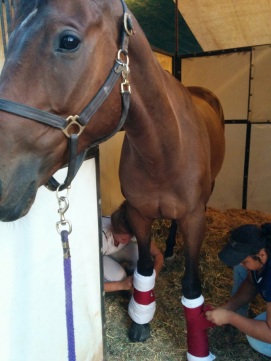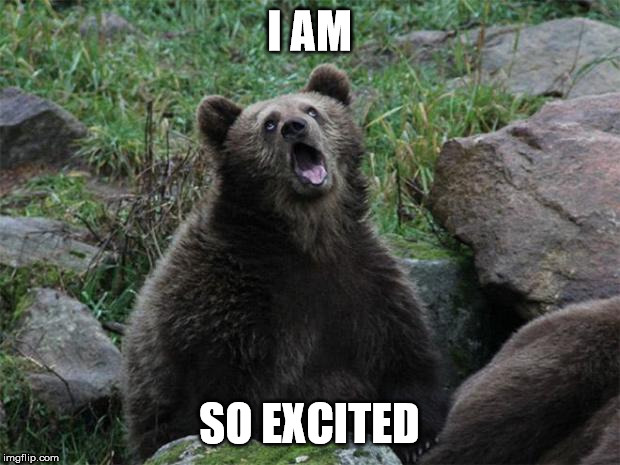If you’re like me, if you’ve read some of Megan’s really interesting, fun, and educational posts on dressage theory and mechanics, you’ve thought “damn*, it would be cool to take a lesson with her!” Well friends, you are correct. IT IS COOL TO TAKE A LESSON WITH HER.
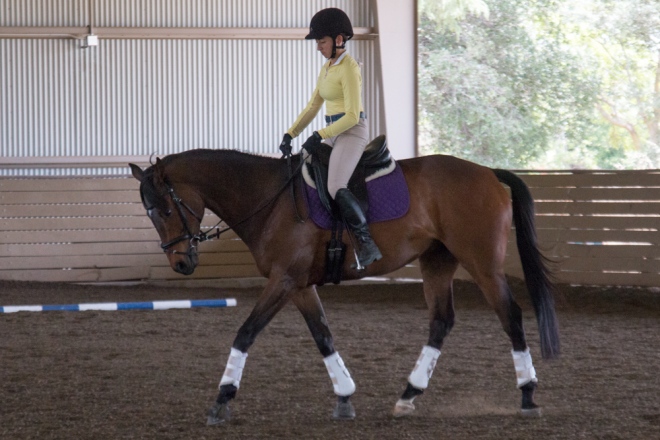 um HELLO DRESSAGE HORSE
um HELLO DRESSAGE HORSE
* I actually intended to write “man” and somehow my fingers just typed out “damn” instead. Take that as part of my review of her teaching, not of my potty mouth.
The day itself was an adventure, but that part of the story I will save for another blog. For now, I’ll talk about the nitty gritty of my lesson, which was all about getting Murray’s body parts lined up in a reasonable way, and not in the way he wants them to be. You see, Murray has too much lateral movement — far too much — and instead of carrying his body so that his hind legs are in line with his front legs (or even so that they are really carrying weight), he wants to fishtail his hind end around and carry all his weight on his front feet. Almost as if he is pivoting around his inside front a tiny bit in each step was how Megan put it. Instead of this pivoting, Megan wanted him to take some more weight on the outside hind and pick up his inside front a little faster. Those pesky diagonal pairs.
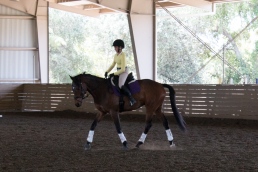 (Little warm up trot pic for comparison to our more put together pics later!)
(Little warm up trot pic for comparison to our more put together pics later!)
Even on a 20-ish meter circle Murray is busily working to evade using his body properly. So instead of me holding him together with “even” pressure on both reins, Megan had me lighten up on the inside rein and really push Murray over into the outside rein. But since he’s so wiggly I had to catch his haunches with my outside leg, and even encourage them to be a tad to the inside. She said (not just to me, but also to other riders) to think of having the ribcage more on the outside than any of his feet. I was to bring his outside hind towards the middle and his inside hind toward the middle.
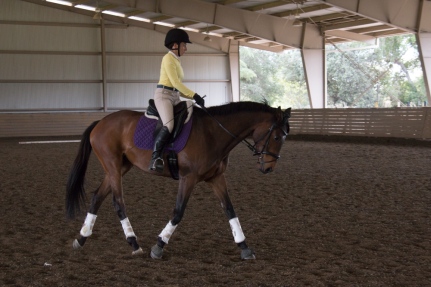 This involved a lot of “haunches inside a little more, push him into the outside rein, open the inside rein and move your hand forward, inside leg at the girth, catch him with the outside leg, that’s too much haunches in but it was beautiful…” etc. Megan gives A LOT of instruction — she said she only expects you to take in a third of it — and it’s true that it’s a lot to hear and process. But it really helps you ride every step more correctly and keep you on the right “feel”. A huge part of the problem for me is that Murray’s crookedness is what I’m used to, so I really have to reprogram myself to feeling Murray’s body when it is going the correct way. Lots of reminders helped me keep putting Murray into the right shape, and reminded me not to rely on my old squeeze — the inside rein.
This involved a lot of “haunches inside a little more, push him into the outside rein, open the inside rein and move your hand forward, inside leg at the girth, catch him with the outside leg, that’s too much haunches in but it was beautiful…” etc. Megan gives A LOT of instruction — she said she only expects you to take in a third of it — and it’s true that it’s a lot to hear and process. But it really helps you ride every step more correctly and keep you on the right “feel”. A huge part of the problem for me is that Murray’s crookedness is what I’m used to, so I really have to reprogram myself to feeling Murray’s body when it is going the correct way. Lots of reminders helped me keep putting Murray into the right shape, and reminded me not to rely on my old squeeze — the inside rein.
 After I got the feel of this straighter body shape in the trot, we moved on to some transitions. Murray likes to bounce around in the walk even more than he does at the trot, so I had to really pick my moment to ask him to trot. Most importantly, I wasn’t allowed to hang on the inside rein, and even if we lost our straightness a bit in the transition I had to work immediately to regain it and not tug on that inside rein. Unfortunately, this new way of going pretty much trashed the smoothness of the transitions. Murray felt that I was no longer there fore him with the inside rein and bounced up into the trot instead of stepping smoothly into it. But as I continued to push his body into the right shape with my legs (“You can go to the inside rein,” Megan said, “But only after you’ve done everything else right with his body to make him get round.”), moving his ribcage out and keeping those haunches from falling too far out, and helping him bring his outside shoulder over with the outside rein, he got more and more used to the idea of the up transition without the oh-so-desireable inside rein.
After I got the feel of this straighter body shape in the trot, we moved on to some transitions. Murray likes to bounce around in the walk even more than he does at the trot, so I had to really pick my moment to ask him to trot. Most importantly, I wasn’t allowed to hang on the inside rein, and even if we lost our straightness a bit in the transition I had to work immediately to regain it and not tug on that inside rein. Unfortunately, this new way of going pretty much trashed the smoothness of the transitions. Murray felt that I was no longer there fore him with the inside rein and bounced up into the trot instead of stepping smoothly into it. But as I continued to push his body into the right shape with my legs (“You can go to the inside rein,” Megan said, “But only after you’ve done everything else right with his body to make him get round.”), moving his ribcage out and keeping those haunches from falling too far out, and helping him bring his outside shoulder over with the outside rein, he got more and more used to the idea of the up transition without the oh-so-desireable inside rein.
 The same thing happened for the trot-canter transitions, but since Murray is less wiggly in the canter it was easier to put him together. Megan called me on one of my oldest weaknesses immediately, and reminded me not to lean in to the canter transition. Murray was even less on board with filling the outside rein in the canter, so I had to work a lot harder to get him moved over with my legs and seat without going to the inside hand. And then suddenly his gait got really big. He had been forward all lesson without too much urging from my legs, but we went from a little canter to an “oh crap I don’t know if we’re going to be able to turn” canter. And I grabbed the inside rein. Megan and I were both laughing about that in the next walk break, because I quite literally said “It was scary!” and she said “You jump cross country, it’s not that scary!”
The same thing happened for the trot-canter transitions, but since Murray is less wiggly in the canter it was easier to put him together. Megan called me on one of my oldest weaknesses immediately, and reminded me not to lean in to the canter transition. Murray was even less on board with filling the outside rein in the canter, so I had to work a lot harder to get him moved over with my legs and seat without going to the inside hand. And then suddenly his gait got really big. He had been forward all lesson without too much urging from my legs, but we went from a little canter to an “oh crap I don’t know if we’re going to be able to turn” canter. And I grabbed the inside rein. Megan and I were both laughing about that in the next walk break, because I quite literally said “It was scary!” and she said “You jump cross country, it’s not that scary!”
 Murray does not appreciate this new way of going
Murray does not appreciate this new way of going
But it was! His gait got HUGE and I didn’t have control of it in the way that I was used to (inside rein), and all I could do to control it was push him out with my inside thigh and catch him with that outside rein and it wasn’t doing anything except making him canter BIGGER AND BIGGER AND BIGGER. Fortunately, Megan also had me sit back more on my right seat bone to help get Murray’s right hind under him, and with that alignment in place all I really had to do was think “trot” and boom — down to the trot. Only it was a giant trot that I was not used to and I got scared and pulled back on that too.

 Murray was really very honest and straightforward in our lesson, which was somewhat miraculous given the start we had to the day. He didn’t like that I was pushing him into the outside rein and not letting his haunches swing around willy nilly, but he took it fairly well and only tried each evasion once (or twice). And I have lots and lots of homework! I haven’t even gotten down to everything I learned from watching Megan teach Peony and another rider, or even everything from my ride! There were a few subtle adjustments to my position as well, which Megan explained really well using Murray’s crookedness and position to help me understand why I was pointing that way or sitting that way.
Murray was really very honest and straightforward in our lesson, which was somewhat miraculous given the start we had to the day. He didn’t like that I was pushing him into the outside rein and not letting his haunches swing around willy nilly, but he took it fairly well and only tried each evasion once (or twice). And I have lots and lots of homework! I haven’t even gotten down to everything I learned from watching Megan teach Peony and another rider, or even everything from my ride! There were a few subtle adjustments to my position as well, which Megan explained really well using Murray’s crookedness and position to help me understand why I was pointing that way or sitting that way.
(How funnily identical are the two above pictures? Extra special thanks to Andy for taking pictures of both me and Peony!)
 Body almost lined up the way we want!
Body almost lined up the way we want!
I’m excited to get Murray straighter and stronger and more through without relying on the inside rein so I can start employing it for more of the fun stuff!









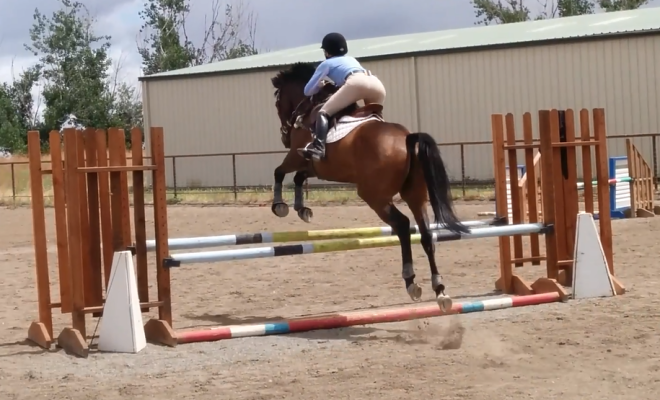

 Why can’t we have uphill XC canter in dressage?!
Why can’t we have uphill XC canter in dressage?!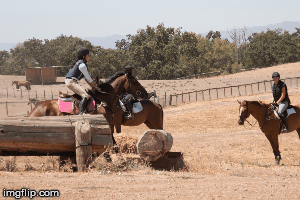

 Sassafrass
Sassafrass


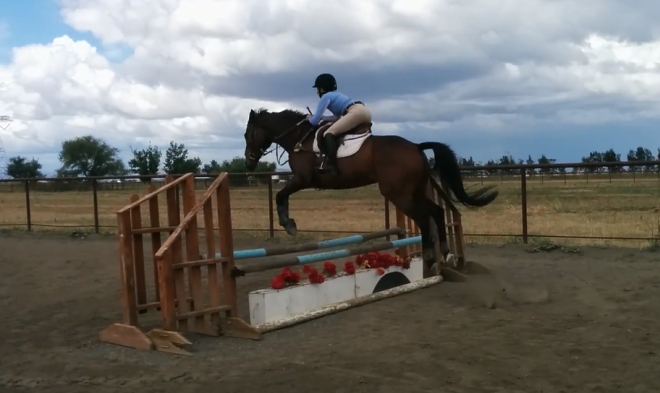
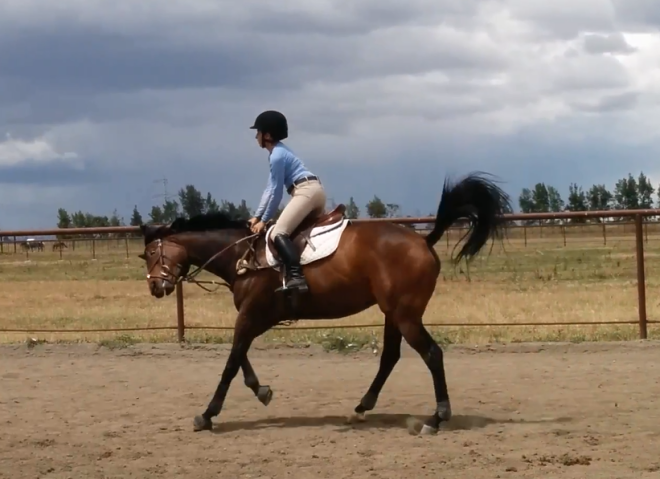 Y u not want to ride dis on XC?
Y u not want to ride dis on XC?




 Murray does not appreciate this new way of going
Murray does not appreciate this new way of going

 Body almost lined up the way we want!
Body almost lined up the way we want!



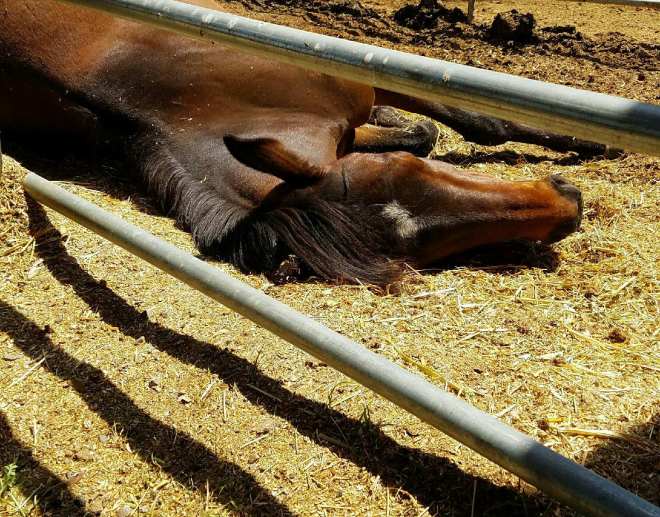

 Freakonomics — How to Become Great at Just About Anything
Freakonomics — How to Become Great at Just About Anything


